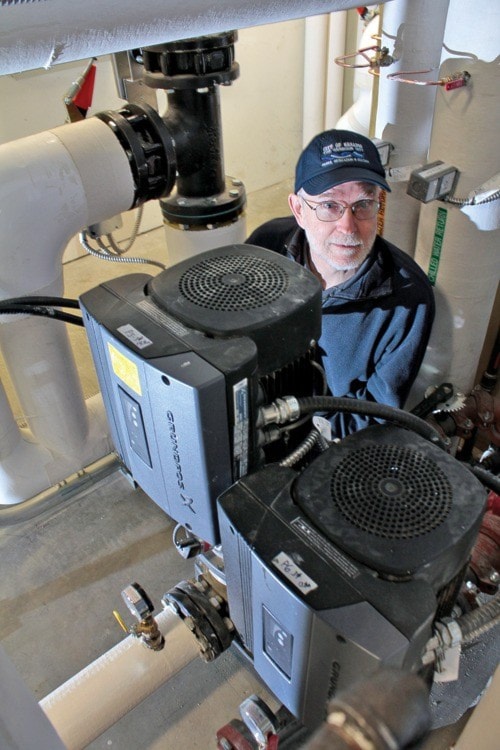The City of Nanaimo’s projects and programs that continue to lower its power bill and cost to the taxpayers is getting the nod from B.C. Hydro and the Applied Science Technologists and Technicians B.C. for.
For nearly a decade, the city has installed LED traffic, street and building interior lights in steady moves away from less efficient incandescent and fluorescent lighting.
Water heating purification systems have been upgraded in Nanaimo’s public aquatic centres where ultra-violet water purification has replaced ozone purification which draws more power.
It doesn’t take much to add up to big savings when one considers that in 2008 city facilities gobbled up just shy of 23.5 million Kw/h of electricity.
Heating and moving large volumes of water and air is expensive. Nanaimo’s main recreation centres alone burn approximately one third of the city’s total electricity consumption and 87 per cent of natural gas.
Nanaimo Aquatic Centre had its boilers replaced in September with condensing natural gas boilers that allow more heat to be recovered from the building’s exhaust air.
“The boilers at NAC have been very impressive,” said Bruce Joiner, city energy manager. “They’ve reduced our bill in the range of $60,000. It’s hard to tell yet how much it will be because we don’t have a full year in yet.”
The recently completed city hall annex incorporates a rotary heat exchanger system that saves waste heat from the building’s exhaust air, recovering thermal energy to heat water channeled through the structure’s heating system which controls temperatures and air exchange in the interior office spaces.
LED lighting fixtures look, at first glance, like fluorescent fixtures, but produce more light for less energy, last longer and can be dimmed.
Solar panels, heat pumps, variable speed water pumps and passive solar features, such as exterior window sun shades, all contribute to the building’s operating efficiency.
The city was presented a TechGREEN award in November for its new water treatment plant and reservoir system project that will incorporate design efficiencies that should save about 260,000 kWh of electricity annually.
If a small water turbine is installed at the facility it could produce an additional 450,000 kWh to power the system.
“The other thing we’ve got going on is we’re actually constructing an energy recovery facility at our No. 1 Reservoir project,” said Bill Sims, Nanaimo water resource manager.
That facility could generate up to about 900,000 kWh annually.
Excess power could be supplied to the electrical grid and sold to B.C. Hydro, creating a revenue source. Incorporation of the water turbine into the system will depend on partner funding from B.C. Hydro, which often invests in projects that lower energy demand and negate the need to construct expensive power generation facilities and infrastructure.
A new water filtration facility will rely on gravity instead of electric pumps to draw water through its filtration system. Estimated savings there could amount to 3 million kWh and hundreds of thousands of dollars in electricity savings annually.
The combined result of completed projects to date is the city consumed more than one million kWh less of electricity in 2011 than it did in 2008.
Heating oil consumption is also down, but the city is currently battling fleet fuel consumption, which continues to rise. Nanaimo RCMP uses about 55 per cent of the city’s fleet vehicle consumption.
The city is cutting back where it can, though, by purchasing hybrid and electric vehicles that includes an electric Ford Ranger, Nissan Leaf electric cars and electric ice resurfacing machines for ice rinks.
